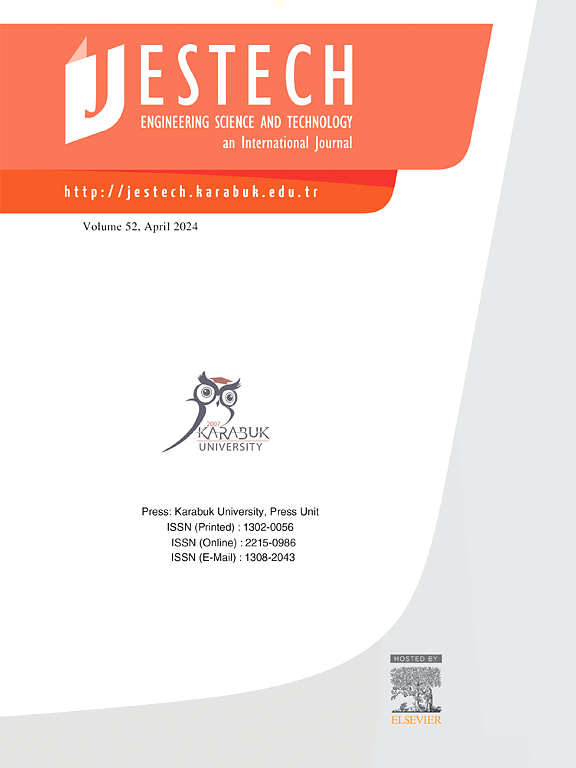Sizing of interoperable EV charging stations on highways with a coordinated charging scheduling strategy
IF 5.1
2区 工程技术
Q1 ENGINEERING, MULTIDISCIPLINARY
Engineering Science and Technology-An International Journal-Jestech
Pub Date : 2025-03-25
DOI:10.1016/j.jestch.2025.102035
引用次数: 0
Abstract
Electric vehicle charging station (EVCS) sizing on highways poses unique challenges compared to urban areas due to the “charge-and-go” tendency of drivers, fewer and more distant stations, and higher charging demand. Unlike urban areas, where prolonged parking enables temporal load management, highways require dynamic spatial load distribution. Special strategies, such as coordinated charging and interoperability, enable efficient and cost-effective EVCS sizing for highways. Therefore, this study proposes a coordinated charging strategy for highway EVCS sizing, incorporating interoperability principles. Charging demand is managed through spatial load shifting and communication between interoperable EVCSs, efficiently utilizing available fast-charging sockets. If no sockets are available, EVs are directed to neighboring stations based on their remaining battery energy. Indirectly, this intelligent redistribution of demand minimizes grid overloads, enhancing system reliability. The method which is applied to Türkiye’s busiest highway reduces charging equipment requirements by 15.2%, significantly lowering initial investment costs. Moreover, spatially distributed charging reduces annual peak power demand by 22.2%, mitigating grid stress by balancing the load across the network. These results highlight the potential of incorporating coordinated charging in EVCS sizing to improve sustainability, feasibility, and scalability of EV infrastructure. This approach offers a replicable framework for tackling EVCS challenges on highways worldwide.
基于协调充电调度策略的高速公路互操作电动汽车充电站规模研究
与城市地区相比,高速公路上的电动汽车充电站(EVCS)规模面临着独特的挑战,因为司机倾向于“充电即走”,充电站数量少,距离远,充电需求高。与城市地区不同,在城市地区,长时间停车可以实现时间负载管理,高速公路需要动态的空间负载分配。特殊策略,如协调收费和互操作性,使高速公路的EVCS规模高效且具有成本效益。为此,本研究提出了一种结合互操作性原则的高速公路EVCS分级协调收费策略。充电需求通过空间负载转移和可互操作evcs之间的通信来管理,有效利用可用的快速充电插座。如果没有可用的插座,电动汽车将根据其剩余的电池能量被引导到邻近的站点。间接地,这种智能的需求再分配减少了电网过载,提高了系统的可靠性。该方法应用于 rkiye最繁忙的高速公路,减少了15.2%的充电设备需求,显著降低了初始投资成本。此外,空间分布式充电减少了22.2%的年峰值电力需求,通过平衡网络负载减轻了电网压力。这些结果突出了将协调充电纳入EVCS规模以提高电动汽车基础设施的可持续性、可行性和可扩展性的潜力。这种方法为解决全球高速公路EVCS挑战提供了一个可复制的框架。
本文章由计算机程序翻译,如有差异,请以英文原文为准。
求助全文
约1分钟内获得全文
求助全文
来源期刊

Engineering Science and Technology-An International Journal-Jestech
Materials Science-Electronic, Optical and Magnetic Materials
CiteScore
11.20
自引率
3.50%
发文量
153
审稿时长
22 days
期刊介绍:
Engineering Science and Technology, an International Journal (JESTECH) (formerly Technology), a peer-reviewed quarterly engineering journal, publishes both theoretical and experimental high quality papers of permanent interest, not previously published in journals, in the field of engineering and applied science which aims to promote the theory and practice of technology and engineering. In addition to peer-reviewed original research papers, the Editorial Board welcomes original research reports, state-of-the-art reviews and communications in the broadly defined field of engineering science and technology.
The scope of JESTECH includes a wide spectrum of subjects including:
-Electrical/Electronics and Computer Engineering (Biomedical Engineering and Instrumentation; Coding, Cryptography, and Information Protection; Communications, Networks, Mobile Computing and Distributed Systems; Compilers and Operating Systems; Computer Architecture, Parallel Processing, and Dependability; Computer Vision and Robotics; Control Theory; Electromagnetic Waves, Microwave Techniques and Antennas; Embedded Systems; Integrated Circuits, VLSI Design, Testing, and CAD; Microelectromechanical Systems; Microelectronics, and Electronic Devices and Circuits; Power, Energy and Energy Conversion Systems; Signal, Image, and Speech Processing)
-Mechanical and Civil Engineering (Automotive Technologies; Biomechanics; Construction Materials; Design and Manufacturing; Dynamics and Control; Energy Generation, Utilization, Conversion, and Storage; Fluid Mechanics and Hydraulics; Heat and Mass Transfer; Micro-Nano Sciences; Renewable and Sustainable Energy Technologies; Robotics and Mechatronics; Solid Mechanics and Structure; Thermal Sciences)
-Metallurgical and Materials Engineering (Advanced Materials Science; Biomaterials; Ceramic and Inorgnanic Materials; Electronic-Magnetic Materials; Energy and Environment; Materials Characterizastion; Metallurgy; Polymers and Nanocomposites)
 求助内容:
求助内容: 应助结果提醒方式:
应助结果提醒方式:


